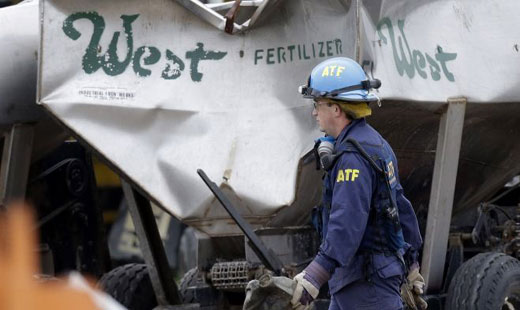
The April explosion at the West, Texas, fertilizer plant that killed 14 people, injured about 200 others and destroyed dozens of homes was so powerful it could be felt 50 miles away, registering as a 2.1-magnitude earthquake.
The blast should continue to rumble throughout the country since the plant’s owner apparently didn’t disclose the dangers there, and the government agencies responsible for protecting the area also failed. Profoundly.
The regulatory failure was explainable but not excusable.
The catastrophe reveals an abdication of responsibilities by corporations and government to protect workers and communities. Agents from the Bureau of Alcohol, Tobacco and Firearms investigated and it seems likely the tragedy was an accident caused by ignorance, negligence, and greed.
Government agencies supposed to oversee such operations didn’t, or couldn’t, and underfunding them is no accident. Choices were made. A company’s financial interests seemingly took precedence over public safety or the well-being of employees. A business played down or ignored the risks.
“It is unlikely that the owners of the West plant intended to kill anyone,” said Penn State law professor Ellen Dannin. “But there was, at least, gross neglect in the siting of the plant in the midst of a town, where the company was situated – so close to the town, schools, and other infrastructure.
“There were many other red flags that cast doubt on the integrity of this company,” continued Dannin, author of Taking Back the Workers’ Law: How To Fight The Assault On Labor Rights. “Those flags can be found in the way they stored the ammonium nitrate, in construction of the building, and in their violation of federal law by failing to report the amounts of the chemical they had on hand.”
Donald Adair’s West Fertilizer Co. and its parent company Adair Grain, Inc., have a history of violations, according to Agence France Presse, which noted the company “paid more than $5,000 in fines in 2012 after being cited for mislabeled cargo tanks and inadequate transport practices, and had been cited by state authorities for a lack of permit in 2006.”
In 2011, the company told the U.S. Environmental Protection Agency that there was no risk of fire or explosion (despite another 27 tons of toxic, flammable anhydrous ammonia there).
The EPA fined the plant in 2006, according to WFAA-TV news in Dallas, which cited evidence the facility paid a $2,300 fine then for “failing to have a risk management plan that met federal standards.” That’s just an outline to ensure chemical accidents don’t happen and to show there are safeguards making such tragedies preventable.
Also, Adair failed to report it was storing 270 tons of ammonium nitrate – 1,350 times the amount that should alert the Department of Homeland Security (DHS) that it should monitor the site, according to Reuters. Any facility holding 400 lbs. of ammonium nitrate is required to report that to DHS.
The danger was obvious. American terrorist Timothy McVeigh used the same fertilizer in 1995 to blow up the Oklahoma City federal building.
“Texas, at least, had every reason to take the hazard of fertilizer explosions seriously,” reported the Society of Environmental Journalists. “An ammonium nitrate fertilizer blast in 1947 at Texas City, Texas, killed at least 581 people – the worst single industrial accident in U.S. history.”
Where was the federal Occupational Safety and Health Administration (OSHA) or its state and local counterparts? OSHA last inspected West Fertilizer in 1985, according to Bloomberg News.
OSHA is hampered by anti-regulation zealots who hamstring its authority and cut its budget. In 1978, the U.S. Supreme Court ruled OSHA needed search warrants to inspect employers’ facilities, weakening the agency’s mandate. Also, lobbied by the chemical industry, Congress during the GOP Bush administration made risk management plans mandated in 1990s Clean Air Act more difficult for the public to find.
Finally, although the worldwide trend is for “privatized regulation” where companies being examined fund the examiners, in the United States, the trend is to starve agencies.
Either way, the results can be deadly.
Required to ensure each worker has safe and healthful working conditions, OSHA has two main functions: Inspecting workplaces and furthering health and safety standards. But OSHA is woefully understaffed and underfunded. With 2,200 inspectors and more than seven million workplaces where 130 million people work, it would take more than 100 years for OSHA inspectors to look over each workplace, says the AFL-CIO.
Compare that to the Department of Homeland Security (DHS).
“Although Americans were 270 times more likely to die in a workplace accident than a terrorist attack in 2011, the DHS’ budget that year was $47 billion, while OSHA’s budget was only $558 million,” wrote labor journalist Mike Elk.
Besides OSHA, EPA and DHS, various agencies should have kept track of the plant. “This tragic explosion points to the need for more resources allocated to OSHA,” said Tom O’Connor, director of the National Council for Occupational Safety and Health. “With adequate funding for more OSHA inspectors, more potentially dangerous sites – like this fertilizer manufacturing plant – can be inspected and hazards abated.”
Former OSHA official Celeste Monforton told Elk that communicating just about terrorist threats shows a system that doesn’t see workplace accidents as a danger.
“A wise public protection system would look at these risks in a more integrated way,” she said. “If you are looking at the hazard of ammonium nitrate, you would look at from a variety of potential ways, it could be mishandled whether it could be stolen or used in a terrorist attack or being used by a company in a way that puts the community and workers at risk.”
There are businesses that are safe and also profitable, of course. But there’s also a mindset that there’s never enough profit and that maximizing income must finally sacrifice safety, workers’ rights and product quality.
So will neighborhoods continue to unknowingly have hazardous facilities near nursing homes, schools and apartment, like at West, Texas? They will if there’s no counterweight to the power of unscrupulous employers.
Writing in the Progressive Populist, former broadcast journalist and business consultant James Moore said: “Generations from now…people may find it hard to understand what we allowed to happen in order to hold down our tax burden and to let industry create jobs and find energy without government meddling.”
Bill Knight is editor of The Labor Paper
Photo: Investigators carry off debris from the destroyed fertilizer plant. LM Otero/AP

MOST POPULAR TODAY

High Court essentially bans demonstrations, freedom of assembly in Deep South

UN warns that Israel is still blocking humanitarian aid to Gaza

Resource wars rage in eastern Congo, but U.S. capitalism only sees investment opportunity

U.S. imperialism’s ‘ironclad’ support for Israel increases fascist danger at home







Comments